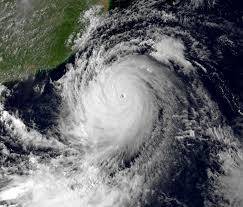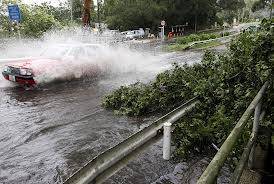Original URL: https://www.theregister.com/2013/09/30/hong_kongs_datacentres_stay_high_and_dry_amid_typhoon_usagi/
Hong Kong's data centres stay high and dry amid Typhoon Usagi
180 km/h winds kill 25 in China, but the data centres keep humming
Posted in SaaS, 30th September 2013 06:31 GMT
Feature When Typhoon Usagi rattled into Hong Kong last week, complete with winds over gale force 8, the city state’s data-centre managers had nothing to fear. Typhoons are a regular part of Hong Kong life and local bit barns are designed appropriately, El Reg was told.
Nevertheless, we were was curious to find out exactly how facilities in this Special Administrative Region (SAR) of China are built to cope with some of the most powerful storms on the planet.
In the end Usagi was a bit of an anti-climax for Hong Kongers. Despite the panic buying and dire warnings, it actually made landfall east of the SAR, although it did claim the lives of 25 unlucky souls in neighbouring Guangdong province.
However, HK is still on the wrong end of about 15 storms every year during the typhoon season of June-September, although most don’t score a direct hit on the tiny region. Last year’s Typhoon Vicente came closest of late, forcing the HK observatory to raise its highest signal, a “T-10”, meaning gusts could exceed 138 mph. Toppling trees brought down power cables; over 200mm of rain fell over two days, causing flooding and landslides; the winds caused a 5ft storm surge in places; and flying debris led to over 130 injuries.
Despite the risk of natural disaster, however, real estate firm Cushman & Wakefield has ranked Hong Kong the safest location in Asia in which to operate a data centre for the past three years. Its Data Centre Risk Index looks at a range of factors including energy costs, bandwidth and ease of doing business, but ranked Hong Kong sixth overall, with a natural disaster ranking of 16 – where 1 correspondents to the least risk.
Interestingly the safest country overall, the United States, had a natural disaster ranking of 29 – more risky than Hong Kong – while second placed UK wasn’t far behind the Chinese SAR with a disaster rating of 12. It seems that aside from typhoons, HK is a pretty safe place to stick a data centre.
Tiered resilience
According to Matthew Chan, associate director at consultancy Arup, all Hong Kong structures have to comply with Buildings Department regulations in areas such as wind load, drainage requirements and facade design.
Aside from that, it is down to the individual data centre operator how much resilience to build in according to which internationally recognised Tier they’re aiming for.
Specific enhancements Chan referenced here included double glazing and anti-blast film on glass to protect from high winds; a “separation corridor” isolating the white space from the external wall of building to act as a buffer; and an effective weather proof louvre, such as one with triple banks and internal drain points.

“For anti-flooding, if the data centre is below the level of the pavement or flooding level, an extra design effort may typically be needed to raise the ground level,” he added.
Fujitsu has a Tier III+ data centre in Hong Kong, which it uses to service customers in the region.
Managed Services GM at Fujitsu Hong Kong, Albert Wong, told The Reg that location was key to the facility.
“In Hong Kong, our Tier III+ data centre is located in Tsuen Wan, a high-lying area which offers better protection against the elements and reduces the risk of flooding during a storm,” he added. “It also benefits from two power sub-stations, which ensure continuity of power supply should service be interrupted. This provides a safeguard should one of the substations fail in a situation such as a typhoon.”
Taking no risks, the Fujitsu facility is also fitted with an automated water leakage detection system to sound the alarm in the event flooding does occur, he revealed.
Savvis data centres in the SAR are all built to withstand a T-10, according to Kevin Wee, director of colocation business development.
“Each Data Hall within the data centre is supported by a dedicated set of mission critical infrastructures based on a 2N (Active, Active) setup with a redundancy factor of N+1 for M&E equipment and a duel loop design for chill water cooling system,” he added. “Any disruption in any data hall will not impact the others.”
Data-centre operator Digital Reality’s new $US200m facility in the suburbn of Tsueng Kwan O is also located, like Fujitsu’s, “well above historic high tide levels” in case of storm surges, according to APAC VP of design Peter Adcock.
He also highlighted back-up power capabilities as key to weathering any severe storm.
“Our TKO facility is Uptime Institute Tier 3 certified. That means that, apart from having two 11kV medium voltage power feeds from separate electricity substations to eliminate a single point of failure, the data centre also offers unlimited or full load power from a fleet of 18 powerful 2.25MVA back-up generators,” Adcock told The Reg.
“These are arranged in an N+1 configuration, so each pair of generators has a separate unit to back them up and during maintenance or even a failure. Fuel tanks located underground provide enough capacity for all of the generators to operate at full load for 24 hours.”
Old barns with new bits
Fujitsu’s bit barn, like many in the SAR, is actually located in a converted industrial building. In fact, the Hong Kong Office of the Government Chief Information Officer (OGCIO) and its Datacentre Facilitation Unit (DCFU) has been promoting the conversion of such premises for some time, aware of the shortage of land available to build on and of the need to attract MNCs which may be eyeing up other Asian locations like Singapore.
“It is the DCFU’s job to guide data-centre operators in the entire process in terms of providing technical advice, facilitating industry’s compliance, liaising with government agencies, and many other acts,” Frost & Sullivan analyst Danni Xu told The Reg.
“For instance, DCFU’s Code of Practice gives stringent guidance on the conversion of industrial buildings for data centre use, while the Lands Department’s Practice Note [addresses] the design and deployment of cooling.”

In the case of converting an industrial building into a data centre, operators need to check if additional work is needed to improve its resilience, Arup’s Chan recommended.
“Due diligence or a feasibility study are required beforehand to review the usage of building, plot ratio, structural loading, utilities availability, and so on,” he said.
Plan, plan, plan
It's not all about the design of the data centre when it comes to ensuring business continuity amid 140 mph winds, however.
"In the case of a typhoon, where there is usually plenty of warning, we bring in additional staff to provide cover for the duration of the storm," said Adcock. "There are sleeping facilities, washing and shower facilities as well as basic catering and food supplies to keep everyone comfortable until the weather moderates."
Stephen Hilton, regional head of engineering and critical facilities at consultancy EC Harris, argued that ensuring business continuity during a severe storm is all about planning and preparation.
“During the time we’re moving from T1 to T3 to T8 we have various procedures – testing systems, cleaning drains, removing things from outside which could blow away, putting sandbags against outside doors. But even without these extra precautions the data centre ... would withstand any ingress of water,” he explained.
“Afterwards it’s about slowly reversing the processes and getting back to work to fix any problems it may have caused. It’s not normal for data centres to be affected, because typhoons are predictable and the risks can be managed.”
Nevertheless it’s wise to expect the unexpected, Hilton warned.
“The last typhoon coincided with the highest tide of the year, so there was a fear in Hong Kong that if it had come from the south we would have got a storm surge,” he added. “We always look at the worst case 100 year event in our planning.” ®